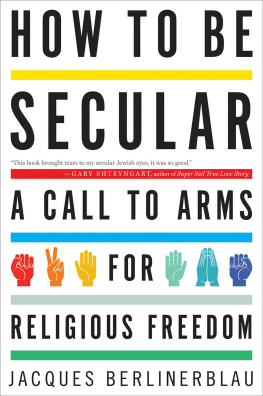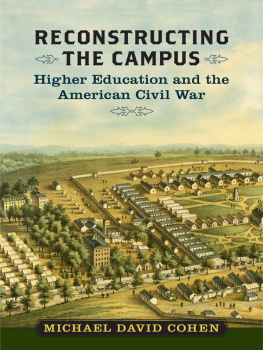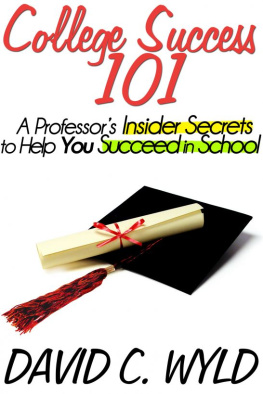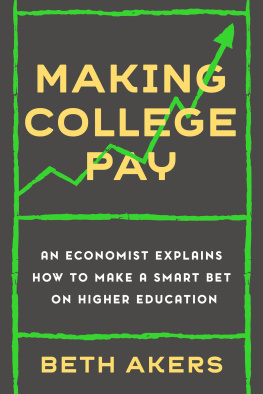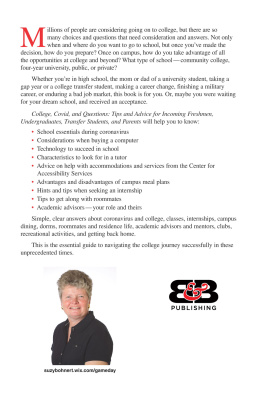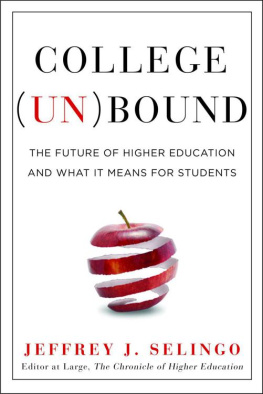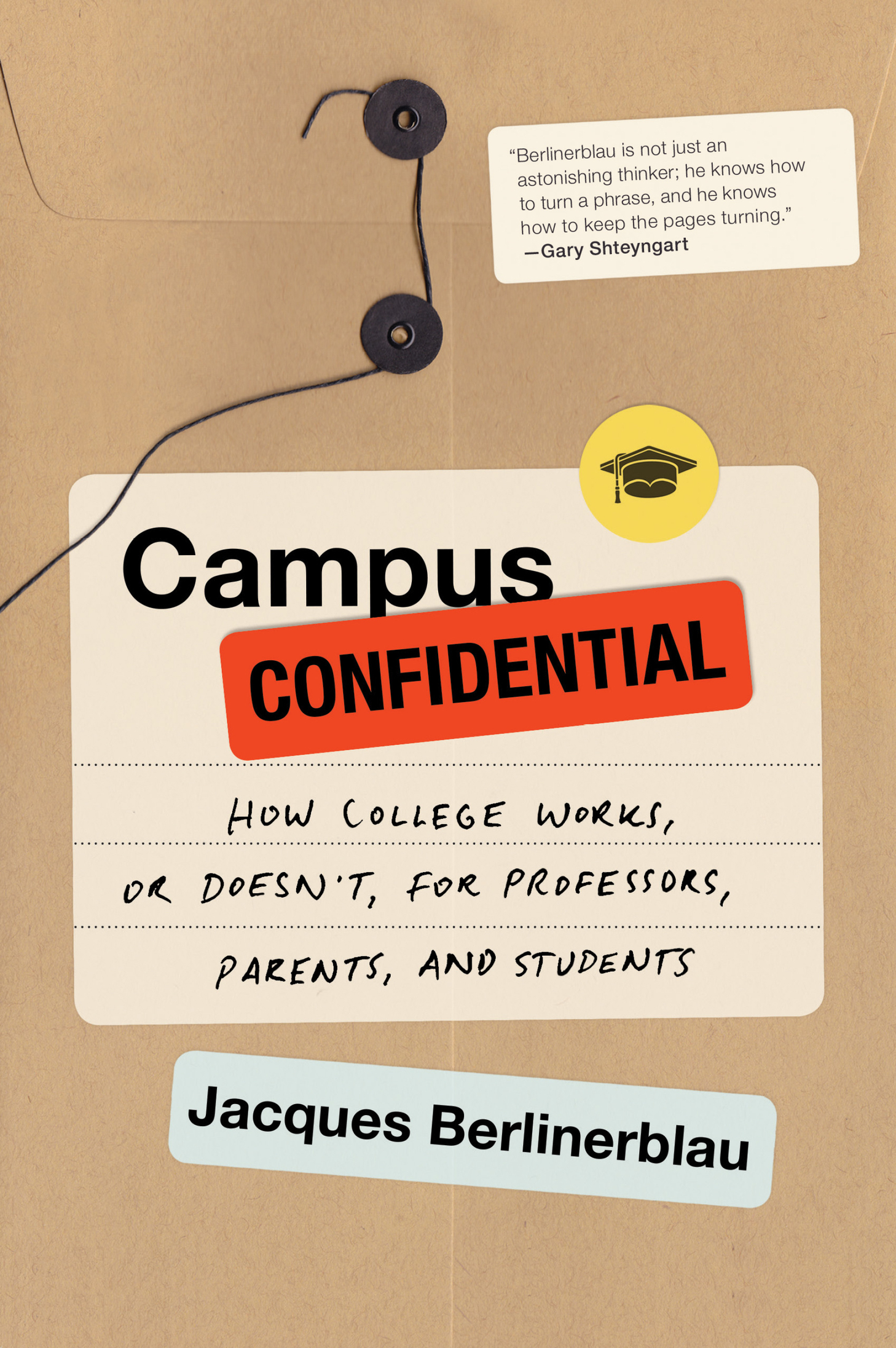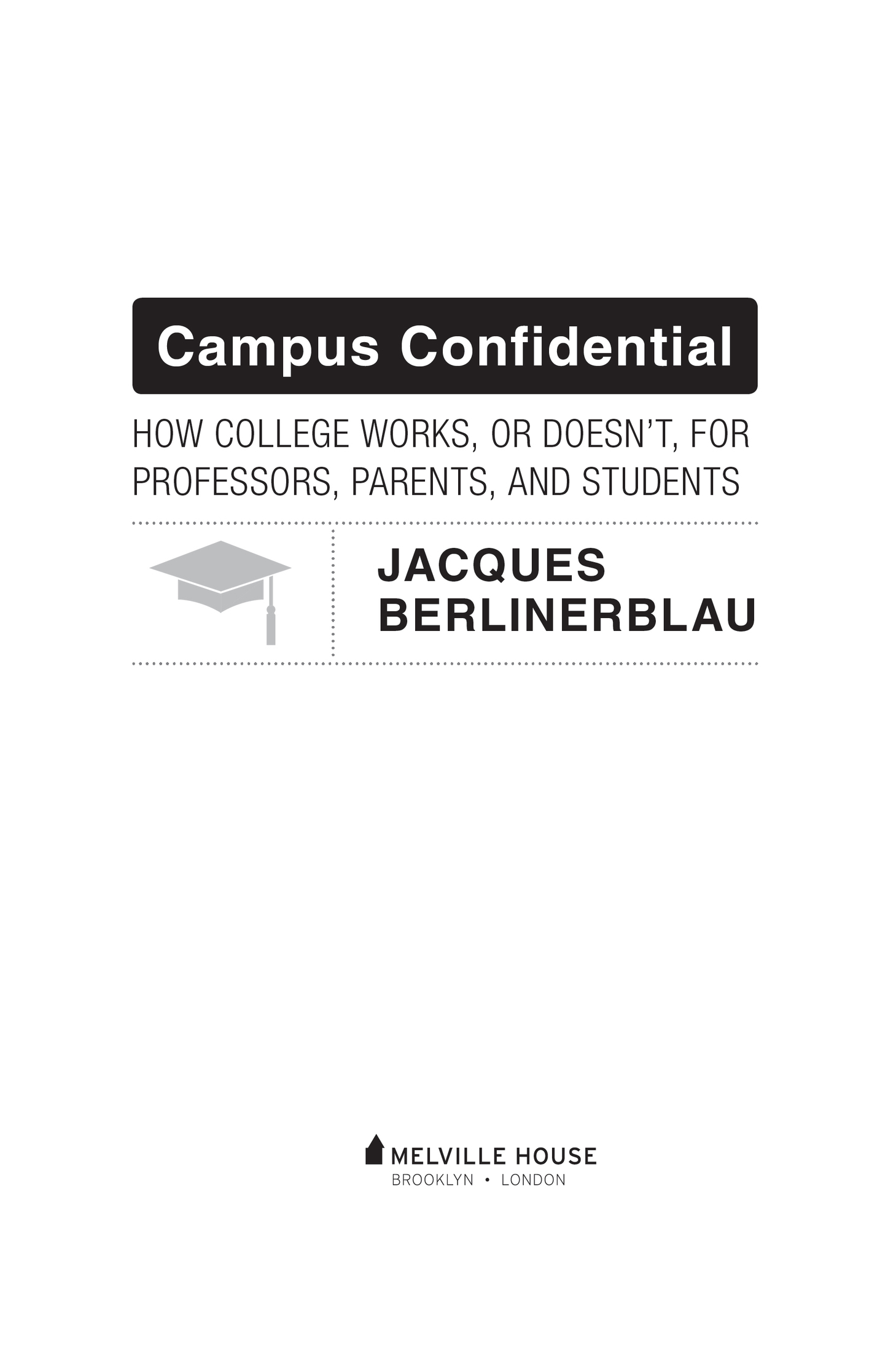Contents
Campus Confidential: How College Works, or Doesnt, for Professors, Parents, and Students
Copyright 2017 by Jacques Berlinerblau
First Melville House Printing: June 2017
Melville House Publishing
46 John Street
Brooklyn, NY 11201
and
8 Blackstock Mews
Islington
London N4 2BT
mhpbooks.comfacebook.com/mhpbooks@melvillehouse
Library of Congress Cataloging-in-Publication Data
Names: Berlinerblau, Jacques.
Title: Campus confidential : how college works, or doesnt, for professors, parents, and students / Jacques Berlinerblau.
Description: Brooklyn, NY : Melville House, 2017.
Identifiers: LCCN 2016057984 (print) | LCCN 2017012741 (ebook) | ISBN 9781612196435 (ebook) | ISBN 9781612196428 (hardback)
Subjects: LCSH: Education, HigherAims and objectivesUnited States. | Universities and collegesUnited States. | BISAC: EDUCATION / Higher. | SOCIAL SCIENCE / Anthropology / Cultural. | EDUCATION / Students & Student Life.
Classification: LCC LA227.4 (ebook) | LCC LA227.4 .B474 2017 (print) | DDC 378.00973dc23
LC record available at https://lccn.loc.gov/2016057984
Ebook ISBN9781612196435
Book design by Jo Anne Metsch
v4.1
a
For Ippolita
After all, my darling, 30 years
is a long time, 30 years
is a long time
Weve been together, 30 years
We raised the kids, darling
BETTY CARTER , 30 Years
Sounds from what youve told me that anything is possible in a college today. Sounds like the people there forgot what it is to teach. Sounds like what they do is something closer to buffoonery.
PHILIP ROTH , The Human Stain
Contents
Introduction
The Lanyards of Despair
Im a FULL PROFESSOR who teaches at a prestigious, almost flouncy, R1 UNIVERSITY . Even though I was TENURED fifteen years ago, no pretentious ASSISTANT PROFESSOR can call me DEADWOOD (yet). Thats because I still churn out PEER-REVIEWED RESEARCH with a serene joylessness that would stagger a Trappist monk.
I test-run the ARTICLES and CHAPTERS in my PIPELINE when I deliver WORKING PAPERS at ACADEMIC CONFERENCES . These take place in stadium-sized conference centers located in American cities I would otherwise never visit. During my allotted quarter hour of speaking time, I relay to my audience (of seven people) the fruits of roughly 1,200 hours of research. This will be followed by a five-minute Q&A session in which someones TRAILING SPOUSE delivers a six-minute manifesto. More A than Q, his oration appears to be completely unrelated to the content of my remarks.
I daze-shamble out of my panel alongside a throng of CONTINGENT and NONCONTINGENT FACULTY . We are all looking for meeting halls in which other incomprehensible, poorly attended TALKS are about to begin. Some of these rooms are named after the state flower or a deceased governor. To an outside observer, our frenzied movements in search of Iris 6 or Blanton 8 must resemble the murmuration of starlings. To an insider, however, these academic get-togethers could be likened to a vast debris field, tragically strewn with thousands of financially struggling DOCTORATES . These scholars have labored for ten, twenty, thirty yearsand still no gainful employment. Their lanyards lie askew upon their breasts. Their name badges, like mine, could just as well read How the hell did it come to this?
How the hell did it come to this? The beleaguered professors of my generation are pondering that. The ceaseless labor, the utter obscurity, the MEDDLESOME , DIPSHIT ADMINISTRATORS this is not what we signed up for in GRADUATE SCHOOL . Back in the 1980s and 1990s, professing the humanities evoked images of soaring like condors, not murmurating like starlings. Scholarship was about the plenitude of spirit. Scholarship was an endeavor both countercultural and noble. Scholarship made the world a better place. Or so we thought.
The generations of doctorates that have come after us see our concerns as frivolous, the academic equivalent of First World Problems. For younger academics, its not so much that the job isnt good. Rather, there simply are no good jobs. This is because colleges and universities will no longer sustain our way of life, nor our plenitude of spirit.
How things have changed since the 1970s. During that Golden Age, nearly 56 percent of American professors possessed TENURE or were on the TENURE TRACK .
What has happened in the intervening half century? One answer has to do with the desire of colleges and universities to drive down costs. Instead of making FRESHLY MINTED PHDS eligible for tenure (which is expensive), American schools are increasingly employing them as expendable, PART-TIME PROFESSORS (which is much, much less expensive). In another disturbing twist, colleges are hiring more NONTENURED FULL-TIME PROFESSORS .
If you are among the 25 million or so Americans who are in college, or paying for college, or applying to college, now may be a good time to start focusing on the theme I am propounding here. For along with GRADUATE STUDENTS and POSTDOCS , these part-time and nontenured full-time professors are the shock troops of college pedagogy. Armed with SYLLABI , it is they who are sent banzai-charging into Americas immense, restive undergraduate population. It is mostly these scholars that staff the GATEWAY and SERVICE courses, as well as the other MASSIFIED classes the TENURE-LINE folks dont wish to teach. This noble, exploited, poorly compensated labor force is responsible for the overwhelming majority of UNDERGRADUATE CONTACT HOURS in the United States.
This absurd arrangement is especially pronounced at Destination Collegesthe one hundred or so elite, blue-chip, name-brand schools in the country. They are distinct from the nations other 4,500-plus institutions of higher education where students matriculate because of geographical proximity, or low cost, or specific vocational degrees they can procure. The Destination Colleges, by contrast, are the Dream Schoolsapplicants would trim their sails to the winds of hell to get into them.
But before high school seniors start futzing with the mast, spar, rigging, gaff, and boom, I ask them to consider this: at these prestigious places, the most accomplished and well-paid professors are kept far away from the undergraduates. Put differently, a Dream Schools most valued scholars are likely completely disengaged from its students. The least valued scholars (i.e., the contingent faculty) usually do most of the teaching. Parents and their kids, gasping for breath under the crushing weight of loans and debt, must also be wondering how the hell it came to this. How can institutions charging $60,000 a year in tuition treat teaching as an opportunity to cut corners? Arent they in the business of educating undergraduates?
Were going to see that it is very difficult to know how undergraduates are actually educated in American college classrooms. A provost can tell you exactly how many kids in the junior class are from South Dakota (a cohort whose presence on campus always inspires curiosity and awe), but she wont be able to tell you in any depth what transpires in those LECTURES and SEMINARS that they attend.


